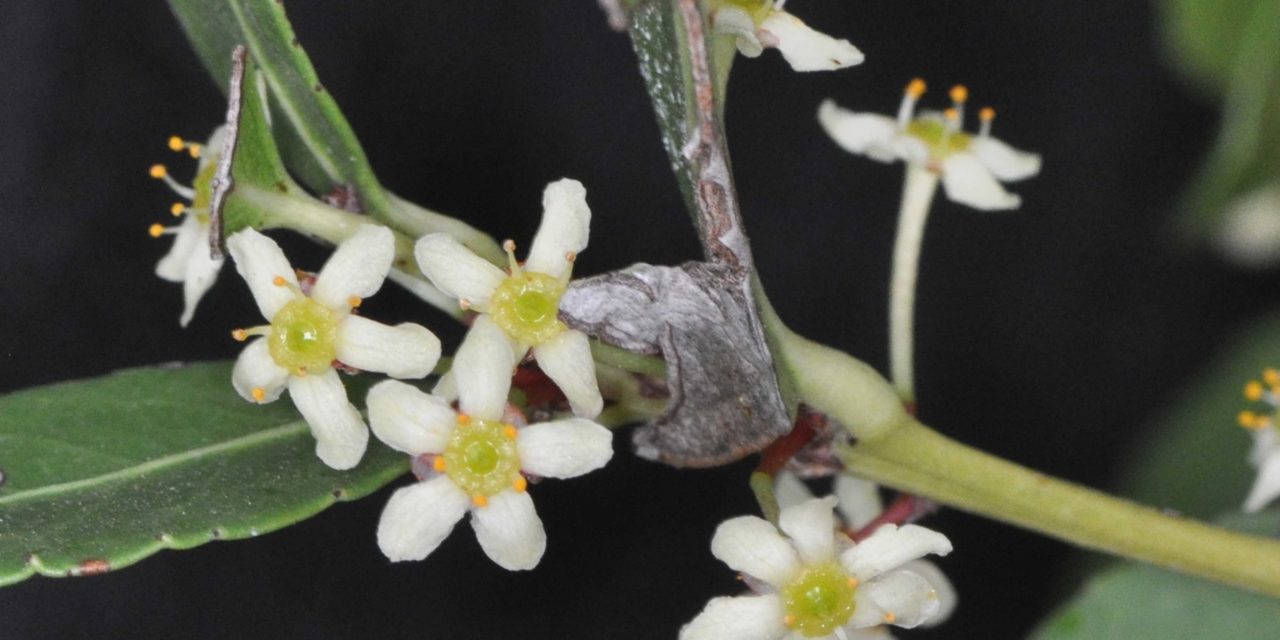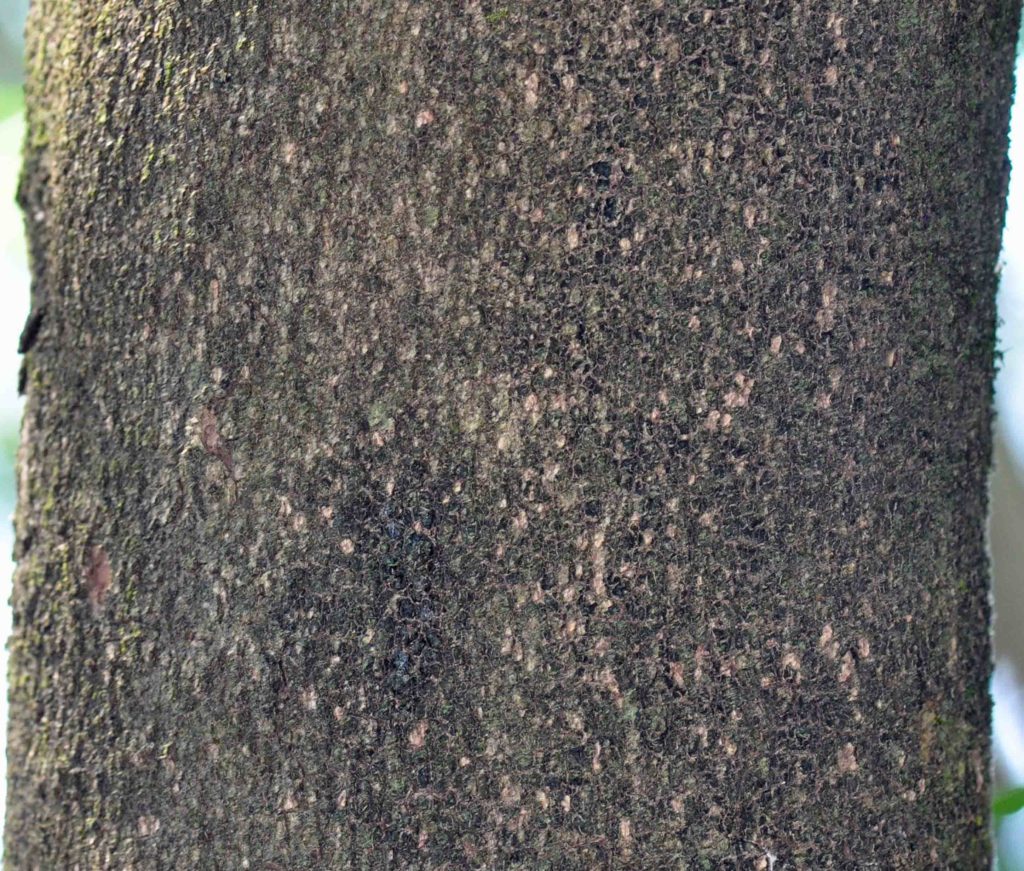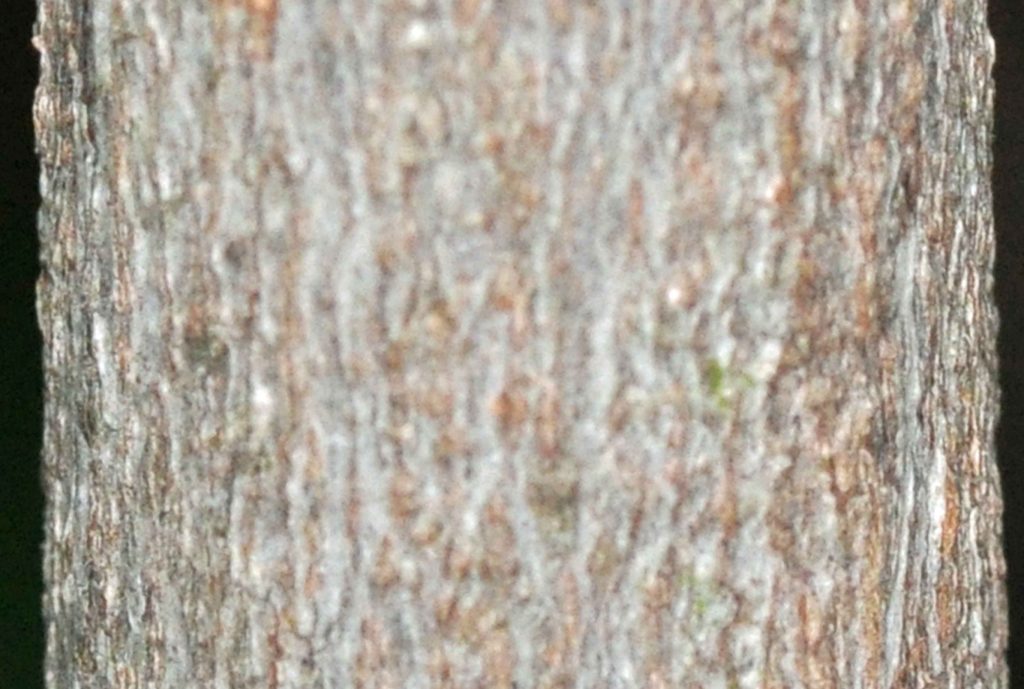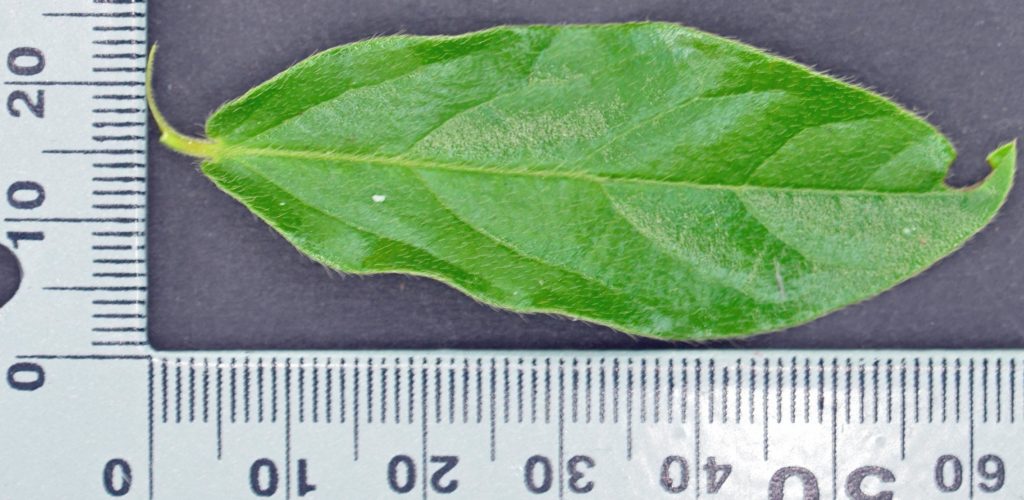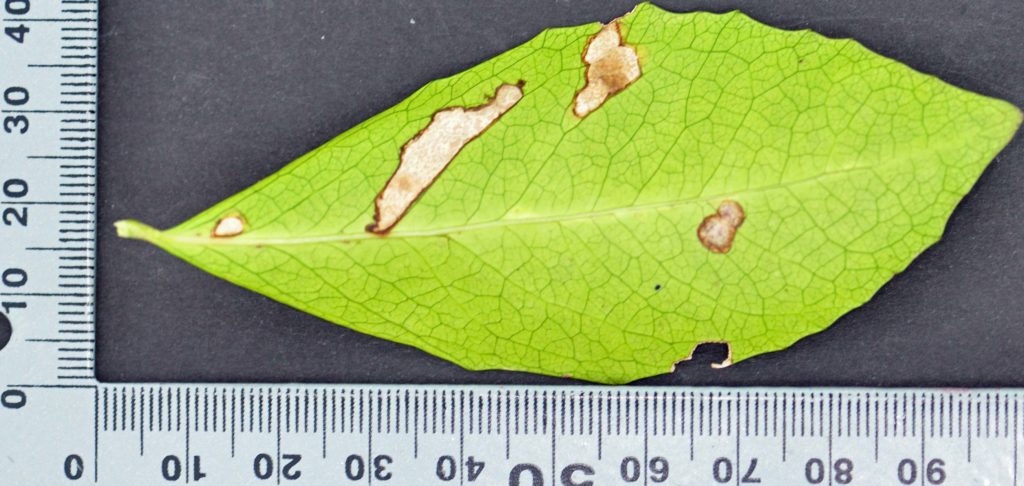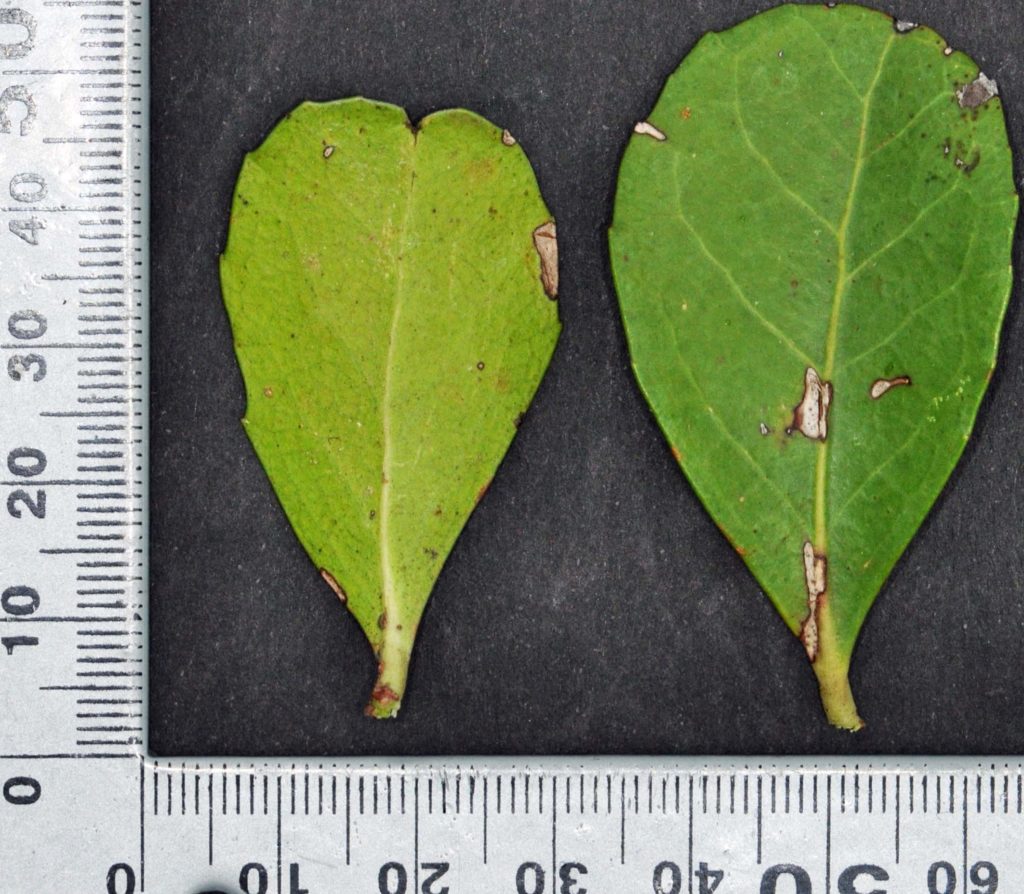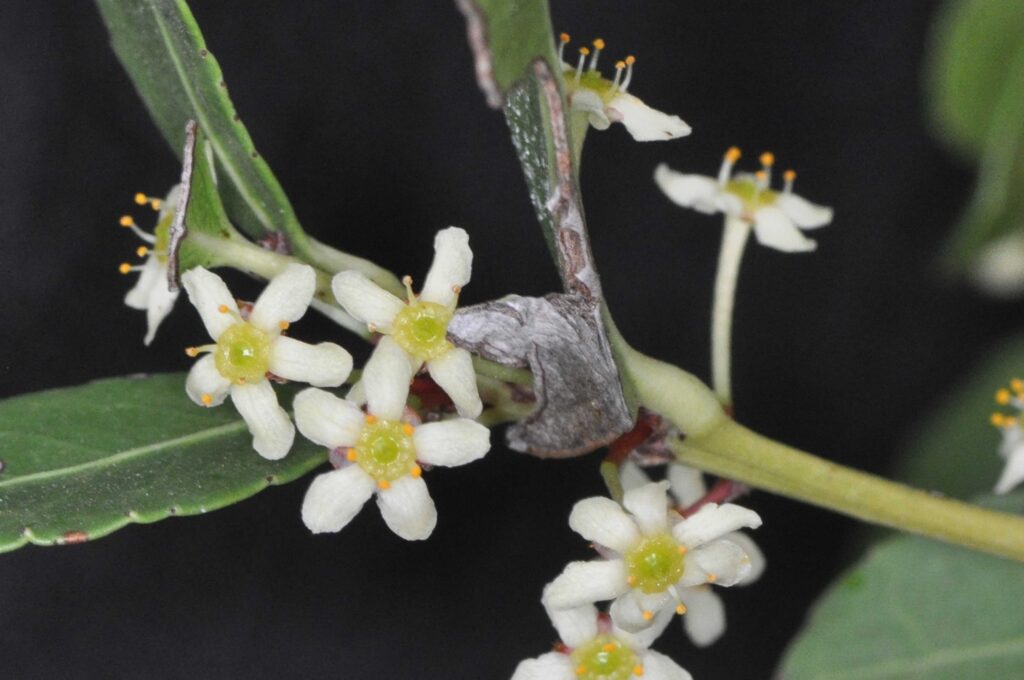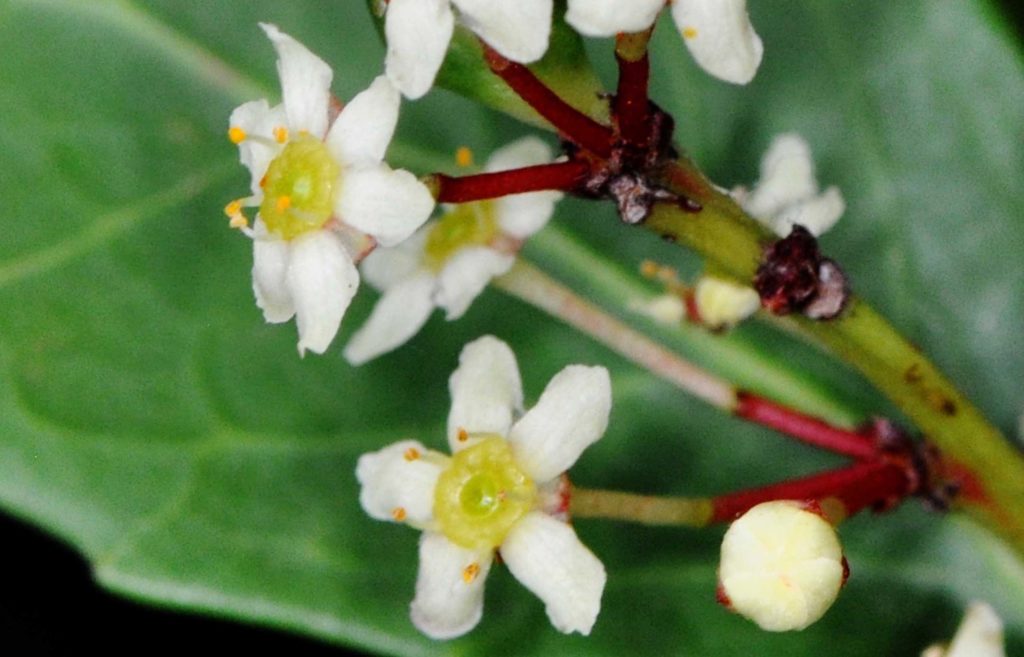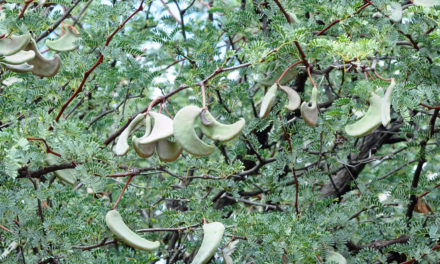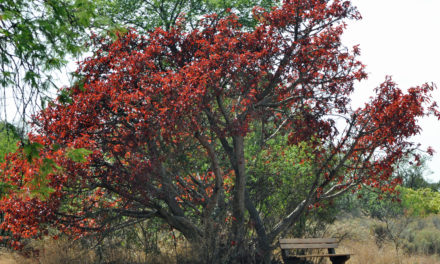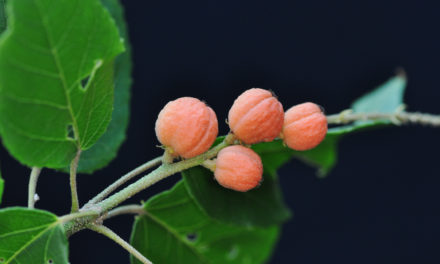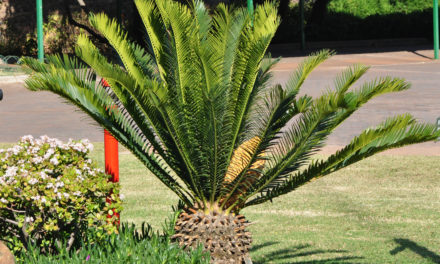General Info – summary
This spineless and variable unarmed evergreen shrub or Tree becomes finely fissured and may reach 12m high. Alternate simple Leaves have weather dependent variable sizes. Margins have gland-tipped serrations. Bisexual, regular, white, small & 5-merous Flowers have 5 stamens & a superior ovary with a short style. The Fruit is a small 3-valved dehiscent capsule. An aril may completely enclose each seed.
Description
Maytenus undata
Previous Names: Aerisilvaea serrate, Catha fasciculate, Celastrus albatus, Celastrus ilicinus, Celastrus undatus, Gymnosporia fasciculate, Gymnosporia peglerae, Gymnosporia undata, Gymnosporia zeyheri, Maytenus fasciculate, Maytenus zeyheri.
SA Tree No. 403.
Common names: (Afr) Gewone Kokaboom, Koko, Kokoboom, Saffraan, Saffraanhout, Transvaalsaffraan, Transvaalsaffraanhout. (Eng) Koko Tree, South African Holly, Transvaal Holly. (isiXhosa) Inqayi-elibomvu, Umgora, Umkokane, Umkokuza, Umnqayimpofu, Umnqayi-mpofu, Umqaqeba Wehlathi. (isiZulu) Idohame, Igqwabali, Indabulaluvalo, Inqayi elibomvu, Inqayi-elibomvu, Idohame. (Northern Sotho) Mokokono, Morokgwa. (siSwati) Sibiyabandla, Umbatancwephe. English Holly plants in the genus Ilex have similar leaves. Koko was historically used to refer to the Khoekhoe – a non-Bantu speaking indigenous nomadic people.
Family: Celastraceae. (Spike-thorn, Staff-tree and Bitter-sweet family). There are currently close to 100 genera and in excess of 1 300 species. About 8 of these are in South Arica. Four are included on this website: Catha, Elaeodendron, Gymnosporia and Maytenus. This family has simple Leaves. Flowers are usually small, actinomorphic (regular), bisexual or unisexual and sepals and petals are usually persistent. One or 2 Pollen sacs are present on each Anther which opens by a longitudinal slit. The Ovary is usually superior and usually has 2-5 locules. The Style is usually thick and the Stigma has 2-5 lobes. Fruit varies.
Name derivation: Maytenus from the Chilian Mayten tree Maytenus boaria. undata – undulate: referring to the often wavy leaf margin. The genus Maytenus has about 50 species with 11 in the southern Africa.
Conservation National Status: L C. (Least Concern). Assessment: 2008 (V.L. Williams, D. Raimondo, N.R. Crouch, A.B. Cunningham, C.R. Scott-Shaw, M. Lötter and A.M. Ngwenya).
Tree
This plant is either, multi-stemmed and shrubby, or a single stemmed tree with a rounded crown and up to 15m high (usually less than half this). The trunk is up to 40cm wide. This unarmed, much branched Tree may branch from the base or within a rounded Crown. The Bark tends to flake. It is initially relatively smooth, grey and finely fissured (photo 39). With time, it becomes rough (photo 629) revealing the pinkish under bark. New angular branches are red to purplish.
- 629 2014.09.14 Lowveld NBG. Photo: David Becking.
- 39 2015.04.24 Witkoppen Nursery. Photo: David Becking.
Leaves
On this evergreen plant, the alternate Leaves are simple (have a single blade which may have incisions that are not deep enough to divide the leaf into leaflets). The leaf shape is variable. Leaves are narrowly to broadly elliptical, lance-shaped and ovate to almost circular. The thinly leathery leaves are usually hairless but hairs may be present (photo 631). Leaves are usually large – up to 9 x 5,5cm (photo 34) but may be much smaller in arid areas. Forest leaves are larger. The upper surface of the leaf blade turns white when tightly folded. Leaves are darker green (even glossy) or bluish green above and usually lighter below. The presence of a powdery white bloom may turn the lower surface a whitish colour. It may be slightly yellow (photo 632). In this photo, the net Veins have a conspicuous network pattern. Side veins are sunken above. The Apex is broadly tapering to rounded and the Base tapers. The Margins are wavy and may have widely spaced serrations that are glandular tipped (photo 632). These may be sharp and give a holly-like appearance. Usually, 4 or more serrations may occur on each side of the margin. The margin may be rolled under. The Petiole (leaf stalk) is up to 8mm long and may be maroon. Parasites may cause leaves to have ear-shaped growths. Stipules (basal appendage of the petiole) are small and lost early. A rubbed leaf leaves a musty smell on fingers.
- 631 2014.09.14 Lowveld NBG. Photo: David Becking.
- 632 2014.09.14 Lowveld NBG. Photo: David Becking.
- 34 2015.04.24 Witkoppen Nursery. Photo: David Becking.
Flowers
The small Flowers are less than 1cm wide, and occur in small, dense axillary clusters. They are bisexual and actinomorphic (Regular, symmetrical. Flowers are vertically divisible into similar halves by more than 1 plane passing through the axis). Flowers are yellow, greenish yellow or white to pinkish. Each flower has a slender, often maroon Pedicel (stalk of a single flower) which is about 7mm long (photo 36). Inflorescences have persistent Bracts (modified leaf associated with reproductive structures). An intrastaminal (located within the stamen whorl of a flower) Disc (a more or less fleshy or elevated development of the receptacle) is present (photo 36). There are 5 Sepals which are joined at the base. They are imbricate (having regularly arranged, overlapping edges, as roof tiles). There are 5 Petals with entire margins that are longer than the sepals and the lobes spread almost horizontally (photo 32). The 5 Stamens alternate with and are much shorter than the petal lodes. The flattened Filaments have Anthers that face inwards (photo 32). The single Pistil (a unit of the gynoecium composed of the stigma, style – when present – and ovary). The sessile, superior Ovary is partially immersed in the disc and the single Style is short. (Aug-Jul).
- 32 2015.04.24 Witkoppen Nursery. Photo: David Becking.
- 36 2015.04.24 Witkoppen Nursery. Photo: David Becking.
Fruit
The initially yellow to reddish small, dehiscent pink or white Fruit is usually a slightly 3-lobed Capsule (a dry fruit resulting from the maturing of a compound ovary that usually opens at maturity by one or more lines of dehiscence). At maturity, the capsule has a diameter of 5-7mm, and becomes reddish brown. The capsule dehisces loculicidally (the locules of capsules split as the fruit opens, and the septa remain intact to the base). A creamy-white to yellow Aril covers the seed. The aril is thin and develops from a stalk, the funiculus, connecting an ovule or a seed with the placenta). In this case it covers the entire seed. The extricated seeds are reddish-brown. (Oct-Jun).
Distribution & Ecology
This plant tolerates sun, shade, drought and frost and thus can survive in divergent habitats. This extremely variable and widely distributed species is frequently found in the bushveld (is a sub-tropical woodland ecoregion of southern Africa) and scrub, in forests, forest margins and rocky places, including on shale formations. It often grows on termite mounds. Bees are involved in pollination. Although it is found in the Karoo and within forests, it is more common in forest fringes. This plant usually occurs below 2 000m – usually lower than this in South Africa. It may be found in the company of the cycad Encephalartos lehmannii in the Pearston District (about 160km north of Port Elizabeth). It is common in the North West, Northern Cape, Eastern Cape, Free State, KwaZulu-Natal, Gauteng, Mpumalanga and Limpopo. Beyond South Africa, it occurs in Lesotho, Swaziland, Mpumalanga, Mozambique, Zimbabwe and northwards into tropical Africa. This plant is also found in Madagascar and the Comoro islands.
Ethnobotany
The reddish, close-grained Wood is hard, dense, has a fine-grain and is easy to work. It was used in wagon construction is used for making farm instruments and spoons. It makes excellent firewood. Seeds or cuttings are used for Propagation. It will grow well in many places as it tolerates sun, shade, drought and forest conditions. Plant extracts have shown some anti-fungal activity. This small, hardy and evergreen plant would do well in gardens.
References
Boon, R. 2010. Pooley’s Trees of eastern South Africa. Flora and Fauna Publications Trust, Durban.
Burrows, J.E., Burrows, S.M., Lotter, M.C. & Schmidt, E. 2018. Trees and Shrubs Mozambique. Publishing Print Matters (Pty) Ltd. Noordhoek, Cape Town.
Coates Palgrave, M. 2002. Keith Coates Palgrave Trees of Southern Africa, edn 3. Struik, Cape Town. p596.
Lawrence, G. H. M, 1951. Taxonomy of Vascular Plants. The Macmillan Company, New York. Tenth Printing 1965.
Palmer, E. & Pitman, N. 1972. Trees of southern Africa. Balkema, Amsterdam, Cape Town.
Schmidt, S. Lotter, M. & McCleland, W. 2002. Trees and Shrubs of Mpumalanga and the Kruger National Park. Jacana, Johannesburg.
van Wyk, B. & van Wyk, P. 1997 Field guide to Trees of Southern Africa, Struik, Cape Town.
Williams, V.L., Raimondo, D., Crouch, N.R., Cunningham, A.B., Scott-Shaw, C.R., Lötter, M. & Ngwenya, A.M. 2008. Maytenus undata (Thunb.) Blakelock. National Assessment: Red List of South African Plants version 2020.1. Accessed on 2023/09/07.
http://www.zimbabweflora.co.zw/speciesdata/image-display.php?species_id=136910&image_id=5
http://repository.up.ac.za/handle/2263/33075
http://www.prota4u.org/protav8.asp?g=psk&p=Maytenus+undata+Blakelock
http://posa.sanbi.org/flora/browse.php?src=SP

